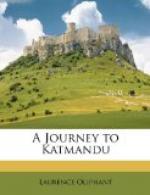But to return to the temple of Pusputnath. This celebrated edifice is said to have been erected by Pussoopush Deoth, the fourth prince of the Soorijbunsee dynasty; and so sacred is the temple considered, that a pilgrimage to its shrines is held to be more meritorious than any other act that can be performed by a Hindoo. As the massive folding-doors opened before us, the view of the court-yard was certainly more striking than anything I had yet seen of the sort. Immediately opposite the handsome gateway, and situated in the centre of the court-yard, was the temple, roofed with lead, while the edges were ornamented with a profusion of gold leaf. Beside the large doors of massive silver were finely carved windows, covered in all directions with devices in the same precious metal.
Four sculptured lions guarded the double flight of steps, while at the bottom of the principal flight was a large figure of a kneeling bull (nanda), executed in copper, and superbly gilt. The rest of the court-yard was filled with images and shrines of various descriptions; a kneeling figure of Siva, a huge bell, more lions, and other sacred objects being studded throughout it in odd confusion. After looking at the varied and somewhat brilliant objects about us, our attention was directed to the roof of the temple, and certainly the transition from the sublime to the ridiculous was extraordinary. Pots, pans, old kukris, dusty-looking musical instruments, goods and chattels of all descriptions, such as one might imagine would form the contents of a Nepaulese pawnbroker’s shop, if there is any such establishment here, were wedged together indiscriminately beneath the projecting roof of the pagoda, for of that Chinese form was this much venerated Hindoo temple. This mass of incongruous wares, as far as I could learn, was composed of the unclaimed goods of pious worshippers, persons dying without known heirs, and certainly, to judge from their appearance, the heirs did not lose much by not establishing their claims.
We ascended the hill, immediately under which the temple is situated, and were charmed with the lovely prospect which it commanded. On the left, and clothing with its brilliant colours a gentle slope, was the grove sacred to Siva, divided by the equally sacred Bhagmutty from the temple we had just visited, and into which we now looked down. The Bhagmutty was crossed by two narrow Chinese-looking bridges, resembling those we have such frequent opportunities of admiring on the willow-pattern plates. It is at this sacred spot that devout Hindoos wish to die with their feet in the water. Here it is that the bodies of the great are burnt; Martibar Singh was reduced to ashes at the end of the bridge, and so was the Ranee not three months before my visit, together with two favourite female slaves, whose society she did not wish to relinquish.
Beyond this interesting foreground stretched the luxuriant valley, its gentle slopes and eminences terraced to their summits, which were often crowned by some old fortified Newar town: the terraces, tinged with the brilliant green of the young crops, rose one above another to the base of the walls, while beneath the Bhagmutty wound its tortuous course to the romantic gorge in the mountains, through which it leaves this favoured valley to traverse lazily the uninteresting plains of upper India.




